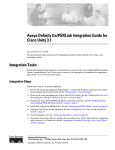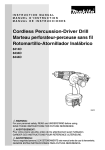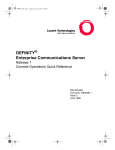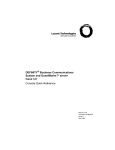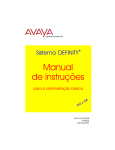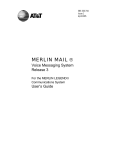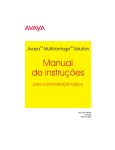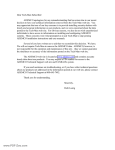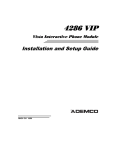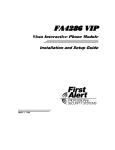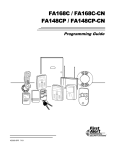Download Lucent Technologies 555-230
Transcript
Cvrfrnt.fm Page 1 Monday, July 28, 1997 11:39 AM DEFINITY® Extender Remote Module User’s Guide 555-230-796 Comcode 107634560 Issue 2 July 1997 Cvrfrnt.fm Page 2 Monday, July 28, 1997 11:39 AM Copyright 1997, Lucent Technologies All Rights Reserved Printed in USA 555-230-796 Issue 2 July 1997 Notice Every effort was made to ensure that the information in this book was complete and accurate at the time of printing. However, information is subject to change. Your Responsibility for Your System’s Security Toll fraud is the unauthorized use of your telecommunications system by an unauthorized party, for example, persons other than your company’s employees, agents, subcontractors, or persons working on your company’s behalf. Note that there may be a risk of toll fraud associated with your telecommunications system and, if toll fraud occurs, it can result in substantial additional charges for your telecommunications services. You and your system manager are responsible for the security of your system, such as programming and configuring your equipment to prevent unauthorized use. The system manager is also responsible for reading all installation, instruction, and system administration documents provided with this product in order to fully understand the features that can introduce risk of toll fraud and the steps that can be taken to reduce that risk. Lucent Technologies does not warrant that this product is immune from or will prevent unauthorized use of common-carrier telecommunication services or facilities accessed through or connected to it. Lucent Technologies will not be responsible for any charges that result from such unauthorized use. Lucent Technologies Fraud Intervention If you suspect that you are being victimized by toll fraud and you need technical support or assistance, call the National Customer Care Center at 1 800 643-2353. Federal Communications Commission Statement This equipment has been tested and found to comply with the limits for a Class A digital device, pursuant to Part 15 of the FCC Rules. These limits are designed to provide reasonable protection against harmful interference when the equipment is operated in a commercial environment. This equipment generates, uses, and can radiate radio frequency energy and, if not installed and used in accordance with the instruction manual, may cause harmful interference to radio communications. However, there is no guarantee that interference will not occur in a particular installation. For further FCC information, see "Customer Support Information" below. Industry Canada (IC) Interference Information This digital apparatus does not exceed the Class B limits for radio noise emissions set out in the radio interference regulations of the Canadian Department of Communications. Le Présent Appareil Numérique n'émet pas de bruits radioélectriques dépassant les limites applicables aux appareils numériques de la class B préscrites dans le reglement sur le brouillage radioélectrique édicté par le ministère le ministère des Industrie Canada. Cvrfrnt.fm Page 3 Monday, July 28, 1997 11:39 AM Trademarks DEFINITY is a registered trademark of Lucent Technologies in the US and other countries. Ordering Information Call: Lucent Technologies Publications Center Voice 1 800 457-1235 International Voice 765 361-5353 Fax 1 800 457-1764 International Fax 765 361-5355 Write: Lucent Technologies Publications Center P.O. Box 4100 Crawfordsville, IN 47933 Order: Document No. 555-230-796 Comcode 107634560 Issue 2, July 1997 For more information about Lucent Technologies documents, refer to the section entitled “Related Documents” in “About This Book” Support Telephone Number In the continental US, Lucent Technologies provides a toll-free customer helpline 24 hours a day. Call the Lucent Technologies Helpline at 1 800 242-2121 or your Lucent Technologies authorized dealer if you need assistance when installing programming, or using your system. Outside the continental US, contact your local Lucent Technologies representative. Warranty Lucent Technologies provides a limited warranty on this product. Refer to “Limited Warranty” in “Customer Support Information.” Contents Customer Support Information ........................ix ■ ■ ■ ■ ■ ■ ■ Support Telephone Number.....................................ix Security of Your System: Preventing Toll Fraud ...............................................x Lucent Technologies Fraud Intervention ..................xi Limited Warranty ......................................................xii FCC Notification and Repair Information .................xiii Installation and Operational Procedures ..................xiv Federal Communications Commission (FCC) Electromagnetic Interference Information ................xvi About This Book ....................................................xvii ■ ■ ■ ■ ■ ■ ■ Intended Audience ...................................................xvii Terms and Conventions ...........................................xviii Typographical Conventions......................................xix How to Use This Book..............................................xix Product Safety Labels ..............................................xx Related Documents..................................................xxi How to Comment on This Document .......................xxiii Issue 2 July 1997 i Contents 1 Introduction ............................................................ 1-1 ■ ■ ■ 2 System Operation and Configuration....................... 1-2 Equipment List.................................................... 1-3 Compatibility ....................................................... 1-5 Options ............................................................... 1-5 Specifications........................................................... 1-6 Considerations......................................................... 1-8 Installation .....................................................................2-1 ■ ■ ■ ■ Location Requirements............................................ 2-2 Electrical Requirements........................................... 2-2 Connecting the Remote Module .............................. 2-3 Installation Procedure .............................................. 2-4 Connections for Data Transmission ................... 2-6 ii Issue 2 July 1997 Contents 3 Programming ................................................................ 3-1 ■ ■ ■ ■ ■ ■ 4 Using the Telephone for Programming ....................3-2 Setting the Telephone Number ................................3-3 Setting the Mode of Dialing ......................................3-4 Setting Pulse Dialing ...........................................3-4 Setting Tone Dialing ............................................3-5 Setting the Connect Rate .........................................3-6 Setting the COM Port Baud Rate .............................3-8 Exiting Programming................................................3-9 Operating the Remote Module ............................ 4-1 ■ ■ ■ ■ Starting the Operation ............................................4-2 Disconnecting .........................................................4-4 Changing a Password ............................................4-6 Checking System Software ....................................4-9 Issue 2 July 1997 iii Contents 5 Troubleshooting ..........................................................5-1 ■ ■ ■ GL Troubleshooting ..................................................... 5-2 LED Sequences ..................................................... 5-3 Error Messages ..................................................... 5-3 Glossary ...........................................................................GL-1 iv Issue 2 July 1997 Figures 1 Introduction 1-1 2 Installation 2-1 2-2 4 System Configuration.........................................1-2 Remote Module Back Panel...............................2-3 RS-232 Cable Pin Connections .........................2-7 Operating the Remote Module 4-1 Connect Sequence for the Remote Module.......4-3 Issue 2 July 1997 v Tables 1 Introduction 1-1 2 Installation 2-1 3 DIP Switch Configuration................................... 2-5 Programming 3-1 5 Remote Module Specifications .......................... 1-7 Telephone Keys Used in Programming............. 3-2 Troubleshooting 5-1 Error Messages ................................................. 5-4 vi Issue 2 July 1997 Important Safety Instructions The exclamation point in an equilateral triangle is intended to alert the user to the presence of important operating and maintenance (servicing) instructions in the literature accompanying the product. IMPORTANT SAFETY INSTRUCTIONS When installing telephone equipment, always follow basic safety precautions to reduce the risk of fire, electrical shock, and injury to persons, including: ■ Read and understand all instructions. ■ Follow all warnings and instructions marked on or packed with the product. ■ Never install this unit or telephone wiring for it during a lightning storm. ■ Never install a telephone jack in a wet location unless the jack is specifically designed for wet locations. ■ Never touch uninsulated telephone wires or terminals unless the telephone wiring has been disconnected at the network interface. ■ Use caution when installing or modifying telephone lines. ■ Use only Lucent Technologies-manufactured DEFINITY Enterprise Communications Server (ECS) circuit packs, carrier assemblies, and power units in the DEFINITY ECS control unit. ■ Use only Lucent Technologies-recommended/approved DEFINITY ECS accessories. Issue 2 July 1997 vii Important Safety Instructions ■ Do not install this product near water, for example, in a wet basement location. ■ Do not overload wall outlets, as this can result in the risk of fire or electrical shock. ■ Do not attach the power supply cord to building surfaces. Do not allow anything to rest on the power cord. Do not locate this product where the cord will be abused by persons walking on it. ■ Unplug the product from the wall outlet before cleaning. Use a damp cloth for cleaning. Do not use cleaners or aerosol cleaners. ■ Do not operate the system if chemical gas leakage is suspected in the area. Use telephones located in some other safe area to report the trouble. WARNING: DO NOT open the Remote Module. There are no user serviceable parts inside the unit. Only an authorized technician should open the unit for required maintenance or upgrading purposes. SAVE THESE INSTRUCTIONS viii Issue 2 July 1997 Customer Support Information Support Telephone Number In the USA only, Lucent Technologies provides a toll-tree customer Helpline (1 800 242-2121) 24 hours a day. If you need assistance when installing, programming, or using your system, call the Helpline, or your Lucent Technologies authorized representative. Outside the USA, if you need assistance when installing, programming, or using your system, contact your Lucent Technologies authorized representative. Issue 2 July 1997 ix Customer Support Information Security of Your System: Preventing Toll Fraud As a customer of a new telephone system, you should be aware that there is an increasing problem of telephone toll fraud. Telephone toll fraud can occur in many forms, despite the numerous efforts of telephone companies and telephone equipment manufacturers to control it. Some individuals use electronic devices to prevent or falsify records of these calls. Others charge calls to someone else’s number by illegally using lost or stolen calling cards, billing innocent parties, clipping on to someone else’s line, or breaking into someone else’s telephone equipment physically or electronically. In certain instances, unauthorized individuals make connections to the telephone network through the use of remote access features. Common carriers are required by law to collect their tariffed charges. While these charges are fraudulent charges made by persons with criminal intent, applicable tariffs state that the customer of record is responsible for payment of all long-distance or other network charges. Lucent Technologies cannot be responsible for such charges and will not make any allowance or give any credit for charges that result from unauthorized access. To minimize the risk of unauthorized access to your DEFINITY ECS: ■ When possible, restrict the off-network capability of offpremises callers, using calling restrictions, Facility Restriction Levels, and Disallowed List capabilities. ■ When possible, block out-of-hours calling. ■ Frequently monitor system call detail reports for quicker detection of any unauthorized or abnormal calling patterns. x Issue 2 July 1997 Customer Support Information ■ Limit Outcalling to persons on a need-to-have basis. The DEFINITY ECS, through proper administration, can help you reduce the risk of unauthorized persons gaining access to the network. However, phone numbers and authorization codes can be compromised when overheard in a public location, lost through theft of a wallet or purse containing access information, or when treated carelessly (writing codes on a piece of paper and improperly discarding them). Additionally, hackers may use a computer to dial an access code and then publish the information to other hackers. Substantial charges can accumulate quickly. It is your responsibility to take appropriate steps to implement the features properly, to evaluate and administer the various restriction levels, and to protect and carefully distribute access codes. Under applicable tariffs, you will be responsible for payment of toll charges. Lucent Technologies cannot be responsible for such charges and will not make any allowance or give any credit resulting from unauthorized access. Lucent Technologies Fraud Intervention If you suspect you are being victimized by toll fraud and you need technical support or assistance, call the National Customer Service Center at 1 800 242-2121. Issue 2 July 1997 xi Customer Support Information Limited Warranty Lucent Technologies Inc. warrants this equipment to be free of defects in materials and workmanship for a period of one year from date of shipment. All defects within this time will be repaired without charge upon return of the unit to the factory. This warranty is null and void if the manufacturer determines that any modifications have been made to the unit or the unit has been subjected to physical or electrical stress. This warranty covers parts and labor only and does not include shipping costs, travel expenses, or travel time. Installation of the equipment is the sole responsibility of the purchaser. The manufacturer, its agents, or its distributors accept no responsibility for malfunction or damage caused by improper treatment or connection of the unit. The manufacturer, its agents, or its distributors are not liable for any losses incurred through use or malfunction of the equipment or any losses or damages incurred by the use of the equipment in any means whatsoever. This warranty is limited to the repair of the equipment to its normal functioning capability. This warranty is complete as stated and all other warranties, expressed or implied, are invalid. The DEFINITY Extender System should be installed only by qualified personnel. No user-serviceable parts are contained within the units. Installation or programming should not begin prior to review of all sections of this manual. xii Issue 2 July 1997 Customer Support Information FCC Notification and Repair Information This equipment is registered with the FCC in accordance with Part 68 of its rules. In compliance with those rules, you are advised of the following: ■ Means of Connection. Connection of this equipment to the telephone network shall be through a standard network interface jack, USOC RJ11C. These USOCs must be ordered from your telephone company. ■ Party Lines and Coin Telephones. This equipment can not be used with party lines or coin telephone lines. ■ Notification to the Telephone Companies. Before connecting this equipment, you or your equipment supplier must notify your local telephone company’s business office of the following: — The telephone number(s) you will be using with this equipment. — The appropriate registration number and ringer equivalence number (REN), which can be found on the back or bottom of the control unit. — For each jack, the sequence in which lines are to be connected, the line types, the Facility Interface Code (FIC), and the Ringer Equivalence Number (REN) by position when applicable. Issue 2 July 1997 xiii Customer Support Information ■ Ringer Equivalence Number (REN). The REN is used to determine the number of devices that can be connected to the telephone line. Excessive RENs on the line can result in the devices not ringing in response to an incoming call. In most, but not all, areas the sum of the RENs should not exceed five (5.0). To be certain of the number of devices that can be connected to the line, as determined by the total RENs, contact the local telephone company to determine the maximum REN for the calling area. ■ Disconnection. You must also notify your local telephone company if and when this equipment is permanently disconnected from the line(s). Installation and Operational Procedures This manual contains information about installation and operational procedures. ■ Repair Instructions. If you experience trouble because your equipment is malfunctioning, the FCC requires that the equipment not be used and that it be disconnected from the network until the problem has been corrected. Repairs to this equipment can be made only by the manufacturers, their authorized agents, or others who may be authorized by the FCC. In the event repairs are needed on this equipment, contact your authorized Lucent Technologies dealer or, in the USA only, contact the National Service Assistance Center (NSAC) at 1 800 242-2121. xiv Issue 2 July 1997 Customer Support Information ■ Rights of the Local Telephone Company. If this equipment causes harm to the telephone network, the local telephone company may discontinue your service temporarily. If possible, they will notify you in advance. But if advance notice is not practical, you will be notified as soon as possible. You will also be informed of your right to file a complaint with the FCC. ■ Changes at Local Telephone Company. Your local telephone company may make changes in its facilities, equipment, operations, or procedures that affect the proper functioning of this equipment. If they do, you will be notified in advance to give you an opportunity to maintain uninterrupted telephone service. ■ New Network Area and Exchange Codes. The DEFINITY ECS software does not restrict access to any new area codes or exchange codes established by a local telephone company. If the user has established toll restrictions on the system that could restrict access, then the user should check the lists of allowed and disallowed dial codes and modify them as needed. ■ Equal Access Codes. This equipment is capable of providing users access to interstate providers of operator services through the use of access codes. Modifications of this equipment by call aggregators to block access dialing codes is a violation of the Telephone Operator Consumers Act of 1990. Issue 2 July 1997 xv Customer Support Information Federal Communications Commission (FCC) Electromagnetic Interference Information This equipment has been tested and found to comply with the limits for a Class B digital device, pursuant to Part 15 of the FCC Rules. These limits are designed to provide reasonable protection against harmful interference when the equipment is operated in a residential environment. This equipment generates, uses, and can radiate radio frequency energy and, if not installed and used in accordance with the instruction manual, may cause harmful interference to radio communications. xvi Issue 2 July 1997 About This Book Intended Audience This book is intended to help in the installation, system administration, and maintenance of the DEFINITY Extender Remote Module. It is intended for use as a reference by anyone needing such information, including system managers, support personnel, sales representatives, and account executives. It is also intended for technicians who are responsible for system installation, maintenance, and troubleshooting. Issue 2 July 1997 xvii About This Book Terms and Conventions The DEFINITY Extender Remote Module will henceforth be referred to as the Remote Module. The DEFINITY Extender Switch Module will henceforth be referred to as the Switch Module. Throughout this document, toll fraud security hazards are indicated by an exclamation point inside a triangle and the words Security Alert. Security Alert: Security Alert indicates the presence of toll fraud security hazard. Toll fraud is the unauthorized use of your telecommunications system by an unauthorized party (e.g., persons other than your company’s employees, agents, subcontractors, or persons working on your company’s behalf). Be sure to read “Your Responsibility for Your System’s Security” on the inside front cover of this book and “Security of Your System: Preventing Toll Fraud” in About This Book. xviii Issue 2 July 1997 About This Book Typographical Conventions Certain type fonts and styles act as visual cues to help you rapidly understand the information presented: Example Purpose Do not recycle old passwords. Italics indicate emphasis. If you do not want to disconnect, go to Step 3. Italics also tell you instructions about what to do next in a procedure. At the "Go Online" screen, press A number in a shaded box is used to designate a key on your telephone. 3 until the following screen appears: Press the Drop button four times. The names of fixed-feature, factory-imprinted buttons on a telephone appear in bold. 2:OK 3:Next Plain constant-width type in a shaded box indicates text that appears on the telephone display. How to Use This Book This book is organized into chapters that give information on procedures necessary for the proper installation and administration of your DEFINITY Extender Remote Module. “Related Documents,” later in this section, provides a complete list of system documentation, together with ordering information. Issue 2 July 1997 xix About This Book If you have problems with your Remote Module, contact your system administrator. If the problem can not be solved by the system administrator, in the continental US, your system administrator will call our toll-free Helpline, available 24 hours a day, at 1 800 242-2121. Outside of the continental US, contact your Lucent Technologies representative or local Authorized Dealer. Product Safety Labels Throughout this document, hazardous situations are indicated by an exclamation point inside a triangle and the word Caution or Warning. WARNING: Warning indicates the presence of a hazard that could cause death or severe personal injury if the hazard is not avoided. CAUTION: Caution indicates the presence of a hazard that could cause minor personal injury or property damage if the hazard is not avoided. xx Issue 2 July 1997 About This Book Related Documents The documents listed below are part of the DEFINITY ECS documentation set. These documents can be ordered from the Lucent Technologies Publications Center. Call: Lucent Technologies Publications Center Voice 1 800 457-1235 Fax 1 800 457-1764 International Voice 765 361-5353 International Fax 765 361-5355 Write: Lucent Technologies Publications Center P.O. Box 4100 Crawfordsville, IN 47933 Issue 2 July 1997 xxi About This Book Document No. Title DEFINITY Enterprise Communications Server (ECS) Release 3 System Documents 555-230-894 Installation for Single-Carrier Cabinets 555-230-655 Implementation Guide, Issue 1 Toll Fraud Security 555-025-600 BCS Products Security Handbook DEFINITY Enterprise Communications Server (ECS) Release 3.0 Telephone User Support 555-230-763 8410 Voice Terminal User's Guide 555-230-765 8434 Voice Terminal User's Guide 555-230-792 Callmaster II and III User's Guide 555-015-168 Callmaster II and III Voice Terminal Installation and Use 555-015-169 Callmaster II and III Voice Terminal Programming Options xxii Issue 2 July 1997 About This Book How to Comment on This Document We welcome your comments, both positive and negative. Please use the feedback form on the next page to let us know how we can continue to serve you. If the feedback form is missing, write directly to: Documentation Manager Lucent Technologies 211 Mount Airy Road Room 2W-226 Basking Ridge, NJ 07920-2332 Issue 2 July 1997 xxiii FEEDBACK FORM DEFINITY® Enterprise Communications Server (ECS), Release 3 Title: DEFINITY® Extender Remote Module Document No.: 555-230-796 Issue: 2 Date: July 1997 1. Please rate the effectiveness of this book in the following areas: Excellent Good Fair Poor Not Applicable Ease of Use Clarity Completeness Accuracy Organization Appearance Examples Illustrations Overall Satisfaction 2. Please check ways you feel we could improve this book: ❑ Improve the overview ❑ Add more examples ❑ Add more detail ❑ Improve the organization ❑ Improve the index/glossary ❑ Add troubleshooting ❑ Add more step-by-step procedures ❑ Improve the table of contents ❑ Make it less technical ❑ Make it more concise ❑ Include more illustrations ❑ Add more/better quick information reference aids ❑ Other 3. What did you like most about this book? 4. Feel free to write any comments below or on an attached sheet. If we may contact you about your comments, please complete the following: Name: Telephone Number: Company/Organization: Date: Address: Send completed forms to: Documentation Manager, Lucent Technologies, 211 Mount Airy Road, Room 2W-226, Basking Ridge, NJ 07920-2332. Fax: 908 953-6912. THIS FORM MAY BE PHOTOCOPIED Introduction 1 An overview of the functioning and specifications of the DEFINITY® Extender The DEFINITY® Extender enables DEFINITY telephone users to be a fully functional part of the PBX telephone system with a digital telephone located any distance off-premise. The Extender is transparent to the user and retains access to the features and functions of the DEFINITY Enterprise Communications Server (ECS). In addition, an RS-232 data port extension is incorporated, allowing the user to connect off-premise RS-232 equipment to equipment at the PBX location. Issue 2 July 1997 1-1 Introduction System Operation and Configuration The DEFINITY Extender system is designed for use with a DEFINITY ECS of Version 3, Release 3 or later. The Extender system consists of two modules. One module, identified as the Switch Module, connects to your PBX. The other module, identified as the Remote Module, connects to your DEFINITY telephone at your off-premise location. Figure 1-1 shows the Extender system configuration. Figure 1-1. System Configuration The modules communicate via a single analog telephone line (also called a “plain old telephone service” [POTS] line), which can extend your DEFINITY telephone to virtually unlimited distances. See “Specifications” later in this chapter for detailed circuit specifications. 1-2 Issue 2 July 1997 Introduction The Switch Module emulates your telephone, and the Remote Module emulates your PBX. Each module features a V.32terbo internal modem for the transmission of all signals between the two modules. With the use of Lucent Technologies’ DEFINITY Extender system, the features and capabilities of your on-premise telephones are extended to those off-premise. ! Security Alert: Using the Remote Module gains access to the features of the DEFINITY ECS, including access to WATS lines, FX lines, etc., which are subject to toll fraud. Guard passwords carefully! Equipment List Your Remote Module package should include: ■ One Remote Module (identified on the top of the unit) ■ One 7-foot standard telephone line cord ■ One AC adapter ■ DEFINITY® Extender Remote Module User's Guide NOTE: A DEFINITY telephone and its associated telephone cord are not supplied with the Remote Module and must be ordered separately. Contact your system administrator or Lucent Technologies representative for information. The Switch Module(s) is also ordered and shipped separately. Issue 2 July 1997 1-3 Introduction You must supply the following for installation: ■ DEFINITY ECS display telephone ■ Telephone cord ■ If you use an 8434D telephone, an MSP-1 power supply ■ If you are connecting the Remote Module to a 240-vac outlet, an adapter to convert to 120 vac. ■ Power and central office line suppressor. Lucent Technologies recommends the 147C AC/CO Line Surge Protector (#8310006). Contact your Lucent Technologies representative for ordering instructions. NOTE: Save your packing materials. Even though the Remote Module is a reliable product, it may be necessary to return it for maintenance. When returning the module, use the original package. 1-4 Issue 2 July 1997 Introduction Compatibility The DEFINITY Extender is compatible with the following commercial two-wire DEFINITY ECS display telephones. ■ 8410D ■ 8434D NOTE: The power supply that comes with the DEFINITY Extender Remote Module cannot produce the power required by the 8434D telephone. An MSP-1 (WP924644) power supply must be used. Check with your Lucent Technologies representative for ordering information. ■ 603 E Callmaster III NOTE: A telephone identical to the 8410D but certified for residential use is being designed. This telephone will be available in the near future. Contact your Lucent Technologies representative for information and availability dates. Options You can order a wall-mounted metal bracket with a slide-in style sleeve for use with the Remote Module. Contact your Lucent Technologies representative for ordering information. Issue 2 July 1997 1-5 Introduction Specifications The DEFINITY Extender system should operate properly with any standard telephone service (also called “plain old telephone service” [POTS] line). Line conditioning may be required if the Switch and Remote Modules do not connect at a data rate of 19.2 kbps. Table 1-1 shows the specifications of the DEFINITY Extender Remote Module. NOTE: Specifications are subject to change without notice as technological or manufacturing changes warrant. 1-6 Issue 2 July 1997 Introduction Table 1-1. Remote Module Specifications Specification Description Size 8.0" x 8.0" x 1.50" (205 mm x 205 mm x 40 mm) Weight 1.5 pounds (0.68 kilograms) Power Requirements 12 vdc supplied by 120-vac adapters. 800 mA maximum Communication Data Type V.32terbo modem Data Impedance 600 Ohms Data Tx Level –15 dBm (+1 dBm/–3 dBm) Data Rx Sensitivity –40 to 0 dBm User Data Port Data Type RS-232 Data Rate Setting 19.2 kbps/9.6 kbps, no parity, 8 bit, 1 stop bit Issue 2 July 1997 1-7 Introduction Considerations Keep the following in mind when you use the DEFINITY Extender system: ■ The DEFINITY Extender system is to be used with a DEFINITY ECS of Version 3, Release 3 or later. ■ No custom calling features, such as Call Waiting or Call Forwarding, should be ordered for the line to which you connect the Remote Module. NOTE: A Call Waiting tone causes an interruption in the call, and the Remote Module will begin the reconnect sequence. ■ Use of the speakerphone on the DEFINITY telephone connected to the Remote Module will degrade voice quality. ■ When you use voice and data simultaneously on the Remote Module, the voice transmission will have priority over the data transmission. ■ Sessions can be established only from the Remote Module. ■ Authorized connections require a password 8 to 10 digits in length. 1-8 Issue 2 July 1997 Introduction ! Security Alert: Using the Remote Module gains access to the features of the DEFINITY ECS, including access to WATS lines, FX lines, etc., which are subject to toll fraud. Passwords should be as long as allowed. Passwords should be hard to guess and therefore should not contain: ■ all the same numbers (for example, 88888888) ■ sequential characters (for example, 987654321) ■ character strings associated with you or with your business. These include: ■ — Names — Birthdays — Business name — Telephone number — Social security number Words and commonly used names Passwords should use as wide a variety of characters as possible. Passwords should be changed regularly, at least on a quarterly basis. Do not recycle old passwords. Issue 2 July 1997 1-9 Installation 2 How to install the DEFINITY® Extender Remote Module Installing the Remote Module involves choosing a proper location and plugging in the LINE, PORT, and power cords. Issue 2 July 1997 2-1 Installation Location Requirements To ensure successful operation of the DEFINITY Extender system, place the Remote Module within 400 feet (120 meters) of the DEFINITY telephone. The Extender module may be mounted in any position or may be wall-mounted by using the optional wallmount bracket. Install the module's power supply and cabling away from high-power/high-RF noise devices such as computers, fans, fluorescent ballasts, and power supplies. Electrical Requirements Use only the AC adapters provided with the DEFINITY Extender system. The Extender has been designed to operate from 120 vac 60 Hz. ! CAUTION: Do not apply power to the Extender module until specifically instructed in the installation procedures. 2-2 Issue 2 July 1997 Installation Connecting the Remote Module All connections to the Remote Module are done via the back panel (see Figure 2-1). Presently no ports are installed for VOICE or COM 2. The current back panel elements are: ■ LINE is the connection between the Remote Module and the central office line for transmission of the signaling information to the Switch Module. ■ PORT is the connection between the DEFINITY telephone and the Remote Module. ■ COM 1 provides for simultaneous RS-232 communication between equipment at the off-premise site and equipment at the on-premise site. ■ COM 2 is reserved for future use ■ +12VDC is the connection for the A/C adapter. ■ The DIP switch under OPT is used for system configuration. Figure 2-1. Remote Module Back Panel Issue 2 July 1997 2-3 Installation In addition to the back panel connections, a three-color lightemitting diode (LED) is visible through the top of each unit and provides information about the status of the equipment. Installation Procedure Installing the Remote Module involves connecting the line cords, the telephone cord, the power cord, and, at your option, the RS-232 cable. The line cord and power cord are supplied with your Remote Module, and the telephone cord and any power cords required for the operation of the telephone are supplied with the display telephone. Follow these steps to install the Remote Module: ! CAUTION: Do not plug the A/C adapters into the electrical outlets until instructed to do so in the following procedure. 1. Ensure that the module has the proper DIP switch configuration (see Table 2-1). 2-4 Issue 2 July 1997 Installation Table 2-1. DIP Switch Configuration Switch # OFF ON 1 Normal operation Reserved 2 Normal operation Dedicated lines 3 Normal operation Reserved 4 Normal operation Test mode NOTE: If you are using a standard central office line, you do not have to change the factory-set DIP switches. Check with your system administrator before making any changes. Your system administrator may have changed DIP switch 3 to the ON position for normal operation. Do not change this setting without contacting your system administrator. 2. Connect one end of the line cord provided with the Remote Module to the telephone company phone jack and the other end to the LINE jack of the Remote Module. 3. Connect the DEFINITY telephone to the PORT jack of the Remote Module by using the cord provided with the telephone. ! CAUTION: Do not plug the line cord provided with the Remote Module into the PORT jack of the Remote Module. Damage to circuits may result. Issue 2 July 1997 2-5 Installation 4. Connect the AC adapter provided with your system to the Remote Module. Plug the adapter into a standard 120-vac electrical outlet. ! CAUTION: Do not plug the A/C adapters into a 240-vac outlet because you will damage the adapter and the module. You must first obtain an adapter to convert 240 vac to 120 vac. 5. The display on the telephone will initialize and read “Go Online?” Connections for Data Transmission By using the COM 1 port on the Remote Module, you can establish simultaneous data transmission between the off-premise location and the on-premise location. Typically this involves a personal computer (a “remote data terminal”) at the off-premise location communicating with an RS-232 server link on-premise (at the DEFINITY ECS location). You will need two straight-through, 9-pin RS-232 cables to establish data transmission. Connect the data terminal at the remote location to the COM 1 port of the Remote Module by using the straight-through cable (see Figure 2-2). 2-6 Issue 2 July 1997 Installation Figure 2-2. RS-232 Cable Pin Connections NOTE: The DEFINITY Extender modules use the CTS line for flow control. When the internal buffer is 32 characters from full, the CTS line is turned off. While CTS is off, up to an additional 32 characters can be transmitted without any loss of data. If hardware flow control is not enabled or if a cable without the CTS line connected is used, characters will be lost when this buffer overflows. The DEFINITY Extender modules use the DCD line to indicate whether or not the modules have made a connection. When this line is on, the modules have made connection. Issue 2 July 1997 2-7 Programming 3 How to program the operating parameters for the DEFINITY® Extender Remote Module Before you can use the Remote Module, you must program the operating parameters, such as the phone number, the type of dialing, and the baud rate of communication. Issue 2 July 1997 3-1 Programming Using the Telephone for Programming Use the DEFINITY telephone to program the operating parameters at the remote location. Prompts will appear on the telephone display. To respond to the prompts, press the dial pad keys on the telephone. Table 3-1 shows the keys used to move to or select programming options. Table 3-1. Telephone Keys Used in Programming Telephone Key Function 1 Allows user to move backward through programming menu. 2 Allows user to select a parameter for programming. 3 Allows user to move forward through programming menu. After you connect your Remote Module and DEFINITY telephone, the following will appear on the telephone display: 3-2 Issue 2 July 1997 Programming To begin programming, press 3 until the first parameter (“Set Phone Number?” ) is shown on the display. If your system administrator preprogrammed your Remote Module, press 2 to begin system operation (see Chapter 4, Operating the DEFINITY Extender.) Setting the Telephone Number If your Remote Module is connected to a standard telephone line, a telephone number to dial must be programmed for proper operation. If your system administrator has not preprogrammed this telephone number for your Remote Module, follow the steps and screens below to set the telephone number on the module. The following screen appears only if the module is configured for dial line operation (DIP switch 2 is OFF). This parameter programs the telephone number used to call the Switch Module. Ask your system administrator for the telephone number to program. 1. Press 2 to select this parameter, or press 3 to advance to the next programming option. If you select 2, either a screen appears showing the current stored number or a blank screen appears if no number has been programmed. 2. To change an existing number or to enter a new number, dial the required digits by using the telephone keys (0 to 9). 3. Press the Drop button on the display telephone to accept the number and return to the main menu. Issue 2 July 1997 3-3 Programming Setting the Mode of Dialing The options for the mode of dialing (tone or pulse) appear only if the Remote Module is configured for dial line operation (DIP switch 2 is OFF). Setting Pulse Dialing Follow these steps to set the mode of dialing to pulse: 1. At the “Go Online?” screen, press 3 until the following screen appears: 2. “Set Pulse Dialing” indicates that TONE dialing is presently activated (factory default). If you want to switch to PULSE dialing, press 2. The following screen appears: 3. Press 2 to accept the change or 1 to cancel the request. 3-4 Issue 2 July 1997 Programming Setting Tone Dialing Setting the dialing mode to “Tone” is very similar to setting it to “Pulse.” Follow these steps to set the dialing mode to tone. 1. At the “Go Online?” screen, press 3 until the following screen appears: 2. “Set Tone Dialing” indicates that PULSE dialing is presently activated. If you want to switch to TONE dialing, press 3. The following screen appears: 3. Press 2 to accept the change or 1 to cancel the request. Issue 2 July 1997 3-5 Programming Setting the Connect Rate Setting the Connect Rate establishes the baud rate in kilobits per second (kbps) for the communications between the Switch and Remote Modules. Follow the steps and screens below to set the Connect Rate. 1. At the “Go Online?” screen, press 3 until the following screen appears: 2. Press 2 to change the connect rate. The following screen appears: 3. Press 3 until the Connect Rate you want appears. There are six choices: ■ Auto—(Factory default). When the auto setting is selected, the module tries to connect at the speed that will provide the best performance with the fewest errors. The speed will vary depending on line performance. If the module is unable to connect at any of the available speeds, an error message appears. ■ F-- —The Remote Module will connect at 19.2 kbps only, the fastest rate. 3-6 Issue 2 July 1997 Programming ■ FM- —The Remote Module will connect at 19.2 or 16.8 kbps. ■ -M- —The Remote Module will connect at 16.8 kbps only. ■ -MS —The Remote Module will connect at 16.8 or 14.4 kbps. ■ --S —The Remote Module will connect at 14.4 kbps only, the slowest rate. NOTE: In some situations, selection of a slower connect rate may result in a more reliable connection. The higher the connect rate you choose, the greater is the possibility of data errors. When a high number of data errors is detected, your call connection may be interrupted while the Remote Module attempts to reconnect. When this happens, you and your caller will hear a beep followed by a message (called the “retrain” prompt): Please remain on the line. This call is experiencing technical difficulties. Your call will resume momentarily. After this message, you and your caller will hear a second beep. The call is restored immediately after the second beep. NOTE: If the line problems cause the call to completely disconnect, you and your caller will hear the following message: We are (still) experiencing technical difficulties on this call. We apologize for this inconvenience. If you initiated this call, please hang up and place your call again. Issue 2 July 1997 3-7 Programming In this situation, the Remote Module tries to reconnect with the Switch Module a maximum of six times. If the connection with the Switch Module is not re-established after the sixth try, the modem disconnects and you must log in again. 4. To view the next Connect Rate, press 3; to view the previous Connect Rate, press 1. Press 2 to accept the Connect Rate displayed. Setting the COM Port Baud Rate You must set the baud rate for the COM 1 port on the Remote Module. This is the rate at which data will be transmitted to and from your remote terminal device, usually a computer. Two rates are available: 19.2 kbps and 9.6 kbps. Follow these steps to set the rate for the COM 1 port: 1. At the “Go Online?” screen, press 3 until the following screen appears: 2. Press 2 to get the Comm Port rate. If 9600 kbps is in effect, the following screen appears: 3. Press 2 to change the setting or 1 to retain the existing setting. 3-8 Issue 2 July 1997 Programming 4. If 19.2 kbps is in effect, the following screen appears: 5. Press 2 to change the setting or 1 to retain the existing setting. NOTE: If your are talking on your display telephone while transmitting data via the COM port, there is not much difference in speed between 9.6 kbps and 19.2 kbps. However, if you are transmitting data only, the 19.2 rate will be significantly faster. Exiting Programming To exit the programming mode, press 1 until the following screen appears: Issue 2 July 1997 3-9 Operating the Remote Module 4 Operating the Remote Module of the DEFINITY Extender Once you have installed and programmed the Remote Module, you are ready to use it. After you have established a connection with the Switch Module (and consequently the DEFINITY ECS), you can use your DEFINITY telephone as you would any other telephone on the system. Issue 2 July 1997 4-1 Operating the Remote Module Starting the Operation You start the operation of the Remote Module by a process similar to logging in on other systems. Follow these steps to start the operation of the Remote Module: 1. At the “Go Online?” screen, press 2 to start the operation of the DEFINITY Extender system. 2. At this point, the Remote Module dials the Switch Module at the programmed number (see “Setting the Telephone Number” in Chapter 3, Programming). Figure 4-1 shows the sequence of messages that appear on the telephone display during connection of the Extender system. 4-2 Issue 2 July 1997 Operating the Remote Module Figure 4-1. Connect Sequence for the Remote Module 3. At the “Enter Password” screen, enter your password and press the Drop button on the display telephone. A valid password must be entered to allow the telephone to be connected to the PBX. Issue 2 July 1997 4-3 Operating the Remote Module NOTE: You must enter your current valid password. The first time you use your Remote Module, the password will be the one initially assigned to you by your system administrator. A valid password contains 8 to 10 digits. 4. If a valid password has been entered, the Remote Module completes the connect sequence and the telephone will be operational. If an invalid password has been entered, you will be prompted to re-enter the password. If after three attempts a valid password has not been entered, the Remote Module will disconnect and the “Go Online?” prompt will be displayed. Check your current password with your system administrator; as necessary, reset your password and repeat the procedure from Step 1. Disconnecting To discontinue operation of the DEFINITY Extender system, follow these steps: 1. Press the Hold button on the display telephone four times. This screen appears: 2. This “Disconnect” screen allows you to change your mind before totally disconnecting. To disconnect, press 2. The disconnect sequence appears on the display; after a few seconds the “Go Online?” screen appears. This indicates you are disconnected. 4-4 Issue 2 July 1997 Operating the Remote Module ! CAUTION: Be sure that you have completely logged off by waiting for the “Go Online?” screen to appear. If you do not completely log off, the Remote Module may continue to try to reestablish the connection, and you will be liable for any applicable toll charges incurred. 3. If you do not want to disconnect, press 3 at the “Disconnect” screen. The following screen appears: 4. Do one of the following: ■ Press 1 to return to the “Disconnect” screen and disconnect the system. The “Go Online?” screen appears, indicating that the DEFINITY Extender system is no longer connected. ■ Press 2 to retain connection. ■ Press 3 to go to the Change Password screen. Issue 2 July 1997 4-5 Operating the Remote Module Changing a Password Follow these steps to change your password. 1. If you are not connected to the PBX, follow the steps in “Starting the Operation” above to connect to the PBX. 2. Once you are connected, press the Hold button on the display telephone four times and the following screen appears: 3. Press 3 and the following screen appears: 4. Press 3 and the following screen appears: 4-6 Issue 2 July 1997 Operating the Remote Module NOTE: If you press 3 and the “View S/W Version” screen appears, check with your system administrator. This indicates that you cannot change your own password. 5. Press 2 change a password. You will be prompted to enter the old password (a * will appear for each digit entered). 6. If the old password is correct, a prompt for the new password appears. Enter the new password (8 to 10 digits). Be sure the new password includes the first two digits of your old password. The first two digits identify your user number. If the old password is not correct, the message “Invalid Password” appears and you are returned to the “Change Password?” screen. Check your password, and repeat Step 5. If you continue to have problems, check with your system administrator. Issue 2 July 1997 4-7 Operating the Remote Module ! Security Alert: Using the Remote Module gains access to the features of the DEFINITY ECS, including access to WATS lines, FX lines, etc., which are subject to toll fraud. Passwords should be as long as allowed. Passwords should be hard to guess and therefore should not contain: ■ all the same numbers (for example, 88888888) ■ sequential characters (for example, 987654321) ■ character strings associated with you or with your business. These include: ■ — Names — Birthdays — Business name — Telephone number — Social security number Words and commonly used names Passwords should use as wide a variety of characters as possible. Passwords should be changed regularly, at least on a quarterly basis. Do not recycle old passwords. 7. Re-enter the new password at the prompt. Press the Drop button on the display telephone to accept the password. 4-8 Issue 2 July 1997 Operating the Remote Module NOTE: The system administrator (user 0) can change all user passwords (see “Changing Passwords” in the “Programming” chapter in the DEFINITY® Extender Switch Module User's Guide). The remaining users can change only their own passwords (user 1 can change only the password which begins with 01). The new password also must begin with 01). NOTE: In some cases your system administrator may have disabled your ability to change your password. Check with your system administrator if you have problems. Checking System Software You can check the system software version used for the Switch Module and the Remote Module. Follow these steps to check the software version. 1. If you are not connected to the PBX, follow the steps in "Starting the Operation" above to connect to the PBX. 2. Press the Hold button on the display telephone four times, and the following screen appears: Issue 2 July 1997 4-9 Operating the Remote Module 3. Press 3 until the following screen appears: 4. Press 2 and the following screen appears: 5. The Switch version screen follows directly: 4-10 Issue 2 July 1997 5 Troubleshooting Troubleshooting, LED Activity, and Error Messages As with all equipment of a sophisticated nature, occasionally an error in connection or transmission may occur. The DEFINITY Extender system provides indication of any errors via light-emitting diodes (LEDs) on the Remote and Switch Modules and by error messages on the display telephone connected to the Remote Module. Issue 2 July 1997 5-1 Troubleshooting Troubleshooting When an error occurs in the operation of the Remote Module, you should check for malfunctions in an organized manner. Follow these steps when troubleshooting the Remote Module: 1. Verify that the programmed telephone number is correct. 2. Check all interconnecting cables to ensure that they are properly seated. 3. Verify that the DIP switches are set correctly. 4. Check the circuits to ensure that they are free of noise and meet the specifications listed in Chapter 1, Introduction. 5. Verify that the power LEDs are illuminated. 6. If you cannot locate the source of the problem, contact your system administrator and describe the problem. 5-2 Issue 2 July 1997 Troubleshooting LED Sequences The following flash sequences may be observed on the Remote Module: ■ 1 Green: Online to Switch Module ■ 2 Green: Waiting for dial tone ■ 3 Green: Dedicated Line mode connect sequence ■ 4 Green: Dial mode connect sequence ■ 5 Green: Program mode (entering parameters) ■ 2 Red: Waiting for telephone connection ■ 3 Yellow: Test mode Error Messages If a problem has been encountered during the connection process, an error message will appear on the display telephone. Table 5-1 shows the error messages and the suggested actions to take. Issue 2 July 1997 5-3 Troubleshooting Table 5-1. Error Messages Message Cause Action No Dial Tone The Remote Module is not properly connected to the local telephone company. Connect a regular telephone to the telephone company jack, and listen for dial tone. Make sure the line is properly connected to the jack on the Remote Module. If you still do not hear dial tone, contact your system administrator. Line Busy The line that the Switch Module is connected to is already in use. Contact your system administrator, and verify that the correct telephone number has been programmed and that no one else is using the Switch Module you are trying to call. No Answer Tone The Switch Module is not responding. The Remote Module does not receive a Ring-Back tone or an Answer Back tone. Report the problem to your system administrator, and verify that the correct telephone number has been programmed. Continued on next page 5-4 Issue 2 July 1997 Troubleshooting Table 5-1. Error Messages—Continued Message Cause Action Rate Too Slow The rate at which the modem is connecting is not fast enough to allow for successful operation of the system. Ensure that no other equipment is connected to the line. Report the problem to your system administrator. Issue 2 July 1997 5-5 Glossary +12 vdc 12 volt direct current. 120 vac 120 volt alternating current (North American standard electrical supply). B Baud Rate The speed in kbps at which digital data can be transmitted. D Direct Line A dedicated circuit or private leased line. Dedicated Subscriber Lines Communication lines (usually twisted pair) that are used to connect onpremise telephone equipment (such as a PBX) to the Central Office. Also referred to as direct lines. Issue 2 July 1997 GL-1 Glossary Dial Line A telephone line which is part of the Public Switched Telephone Network and is accessed through the DEFINITY Extender’s automatic dial-up function. F Facility Transmission facilities. Usually a two metallic pair set of cords, but can be Telco carriers, T-1, microwave or dial-up telecommunications lines. L LED Light-emitting diode. A semiconductor diode which emits light when a current is passed through it, indicating that the power is on. O On-premise Lines Communication lines (usually twisted-pair) that are used to connect the PBX to the DEFINITY telephone. GL-2 Issue 2 July 1997 Glossary P PBX Private Branch Exchange. R Remote Module The DEFINITY Extender module that connects to the remote DEFINITY telephone. S Switch Module The DEFINITY Extender module that connects to the DEFINITY PBX. Issue 2 July 1997 GL-3








































































